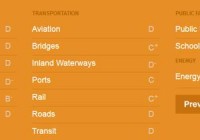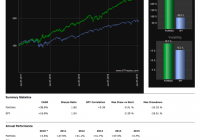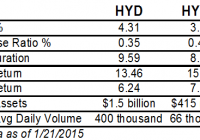Gain Exposure To U.S. Infrastructure Boom With GII
Summary Poor American infrastructure has an overall Grade of D+ by American Society of Civil Engineers. Congested roads alone cost America $101 billion in fuel and wasted time in 2010 and last major infrastructure work was in 1956 by President Eisenhower. President Obama called for greater infrastructure work in his 2015 State of the Union Address and is expected to push for wider infrastructure development. GII is a global infrastructure ETF loaded with world class infrastructure companies that are likely to be called to service in the upcoming infrastructure upgrade. Investors can add a small position of GII before adding to it. America’s Infrastructure Investment Opportunity The American Society of Civil Engineers (ASCE) is the premier organization with expertise on infrastructure works in America founded since 1852. ASCE produces a grading score of condition and performance American infrastructure every 4 years and the latest report published on 2013 was given an overall grade of D+. Their grading system follows the typical school grades where A represents Excellent, B represents Good, C represents Mediocre, D represents Bad and F represents failing. So American infrastructure is only 1 grade above failure and graded as bad. Before we go further in the economic implication of this state of disrepair for American infrastructure, let us have an idea of the scope of infrastructure by the grades of the categories of Water and Environment, Transportation, Public Facility and Energy below. (click to enlarge) Source: American Society of Civil Engineers ASCE has estimated that America requires $3.6 Trillion of infrastructure investment by 2020 to meet the infrastructure needs of America. This represents a huge investment opportunity which we can tap into through a diversified holding of infrastructure related companies through an Exchange Traded Fund (NYSEMKT: ETF ) which will be recommended at the end of this article. Cost Poor Infrastructure We will use the transportation category with roads in particular to illustrate the cost of poor infrastructure. We are all familiar with traffic congestion during rush hour where we are forced to endure hours on the road. This is a very real life example of the cost of poor infrastructure works. It is estimated that an average of 34 hours spent waiting on roads and burning 1.9 billion gallon of oil costing motorists $101 billion in 2011. 42% of America’s major urban highways remains congested and 32% of major America’s roads remain in poor or mediocre condition. (click to enlarge) This is the result of steadily falling investments on transportation as seen in the chart above. President Obama prevented a temporary boost by adding provisions for transportation investment in the 2009 Recovery Act but they were a short term boost and have since been depleted. Overall they are not sufficient to reverse the aging roads of America. The last major infrastructure work was done 59 years ago when President Dwight Eisenhower signed the Federal Aid-Highway Act of 1956 , which added 41,000 miles of interstate highways that linked different states of America together. It was completed in 1980 and represents 1% of road network in America but it carries 23% of all railway traffic. It was heralded as a major achievement at that time but 35 years later more funds are needed to maintain this vast network of roads. Obama Calls for Action During the State of the Union Address on 21 January 2015 before Congress, President Obama made the following rallying call for the United States to upgrade its failing infrastructure. “21st century businesses need 21st century infrastructure – modern ports, stronger bridges, faster trains and the fastest internet. Democrats and Republicans used to agree on this. So let’s set our sights higher than a single oil pipeline. Let’s pass a bipartisan infrastructure plan that could create more than thirty times as many jobs per year, and make this country stronger for decades to come.” There are various laws that can make this happen including the popular Transportation Infrastructure Finance and Innovation Act (TIFIA) which can be expanded further and modernizing the Federal Financing Bank (FFB) to allow for greater Public Private Partnership (NYSE: PPP ). Australia’s experiment with PPP in the 1990s should be instructive to benchmark expectations of return. Primary infrastructure returned a yield of 7%-8% and secondary infrastructure returned 13%-15%. Obama tried to make transportation infrastructure a priority in 2014 and we expect him to build on his momentum of an improving economy to try again this year in 2015. With third quarter economic growth of 5% at 11 year high, we expect Obama to seal his legacy with a wide range of infrastructure works. Infrastructure ETF Capital protection is the key word for investors and this can be achieved by investing in a diversified portfolio of stocks that an exchange traded fund ( ETF ) can provide. The SPDR S&P Global Infrastructure ETF (NYSEARCA: GII ) includes world class infrastructure companies that are likely to be called upon to build the US infrastructure. The top companies in this ETF include Transurban Group ( OTCPK:TRAUF ) (5.13%), Atlantia ( OTC:ATASF ) (4.14%), Duke Energy Corporation (NYSE: DUK ) (3.54%), Enbridge (3.43%) and Abertis Infraestructuras SA ( OTCPK:ABRTY ) (3.36%). I would provide a brief description of these companies for investors to have an understanding of the types of companies that they are gaining exposure with GII. Transurban manages and develops urban toll road networks in Australia and North America. Atlantia is an Italian company that constructs and operates toll roads. Duke Energy, headquartered in Charlotte, North Carolina, is the largest electric power holding company in the United States. Enbridge is an energy delivery company based in Canada specializing in the transport and distribution of crude oil, natural gas, and other liquids. It has 41.79% weighting in Utilities, 39.79% in Industrials, 17.67% in Energy and 0.76% in Basic Materials. Abertis is a Spanish company that operates motorways in Europe and airports in cities like London and Orlando. (click to enlarge) We can see that GII has been ranging from $47 to $49 past 2 weeks and recent price action have a bullish slant to it. GII is decently priced at with 19 times price earnings and it has a market capitalization of $111.73 million and volume of 2,592. Investors can consider taking a small exposure of GII and look out for further action on the Obama Administration before adding to their position.


